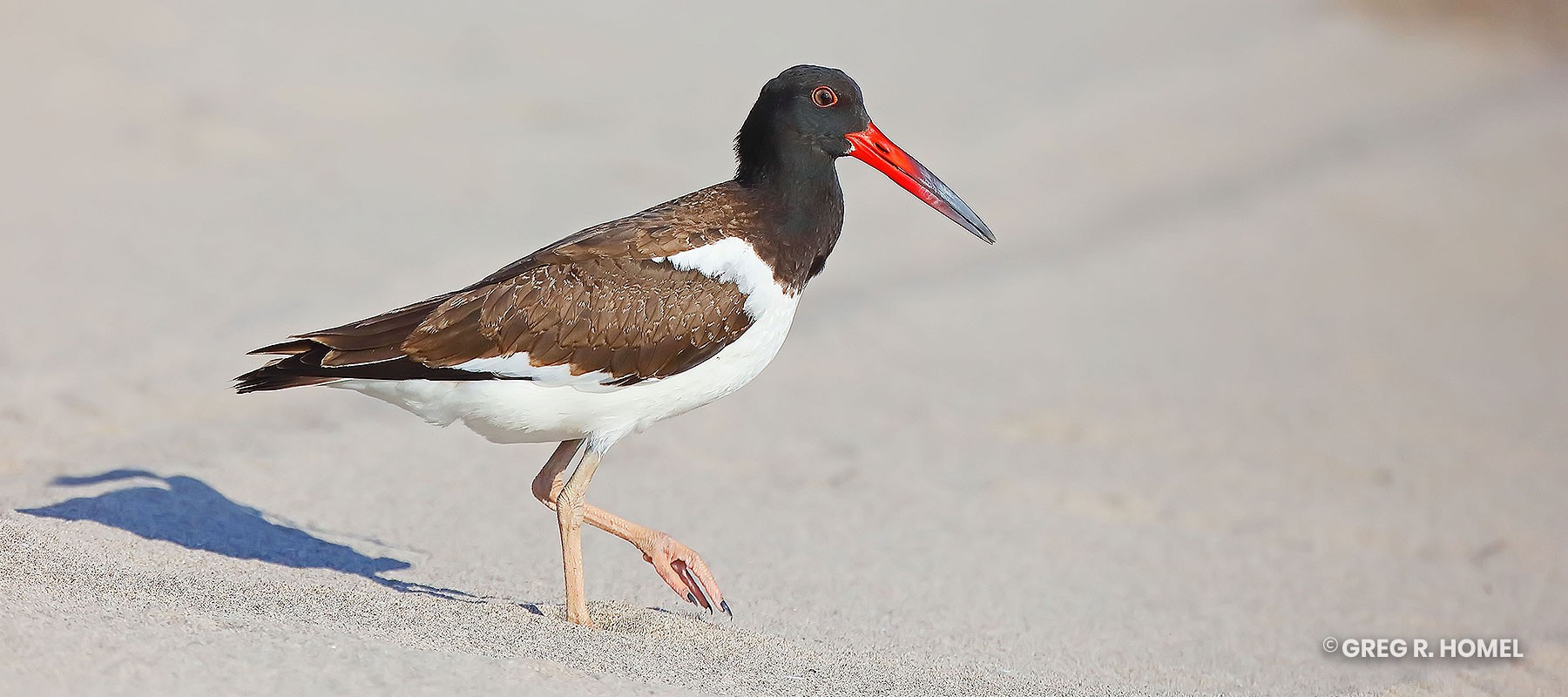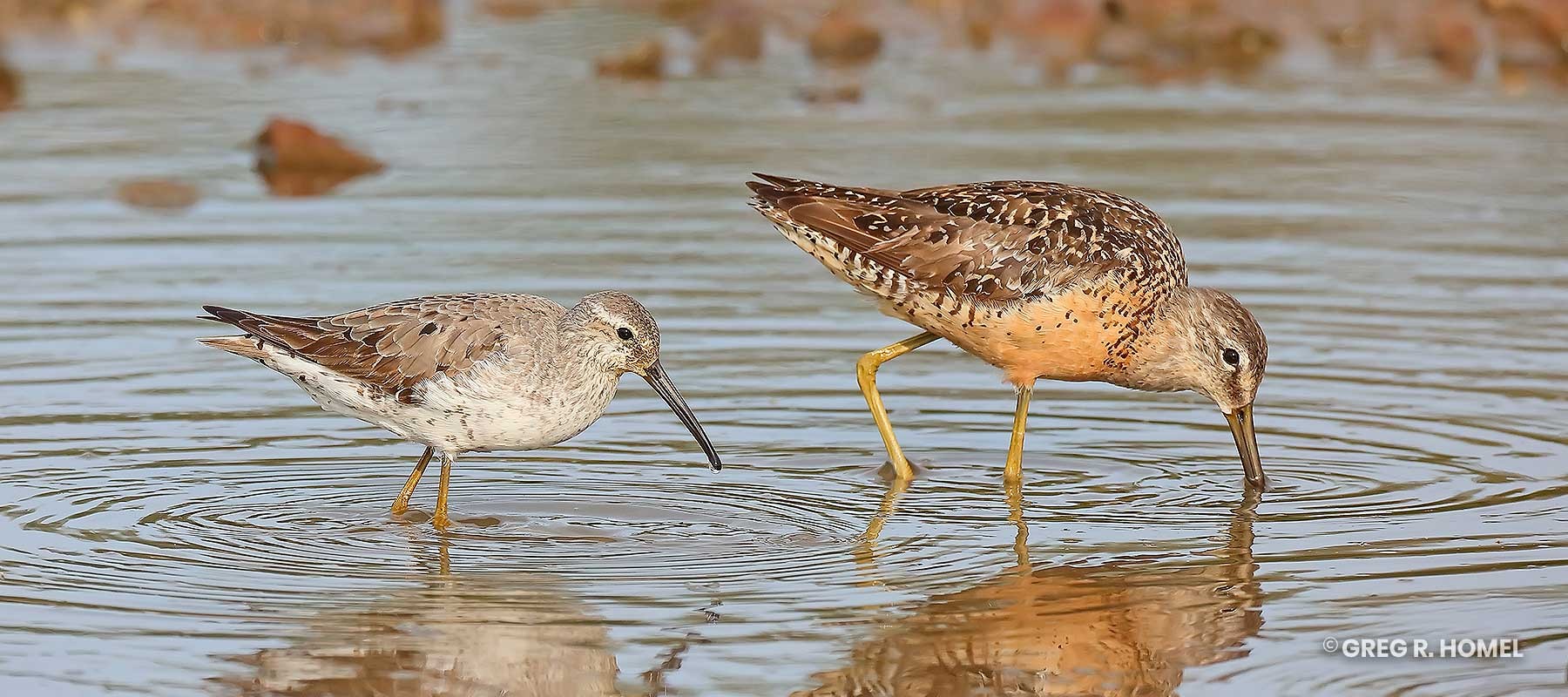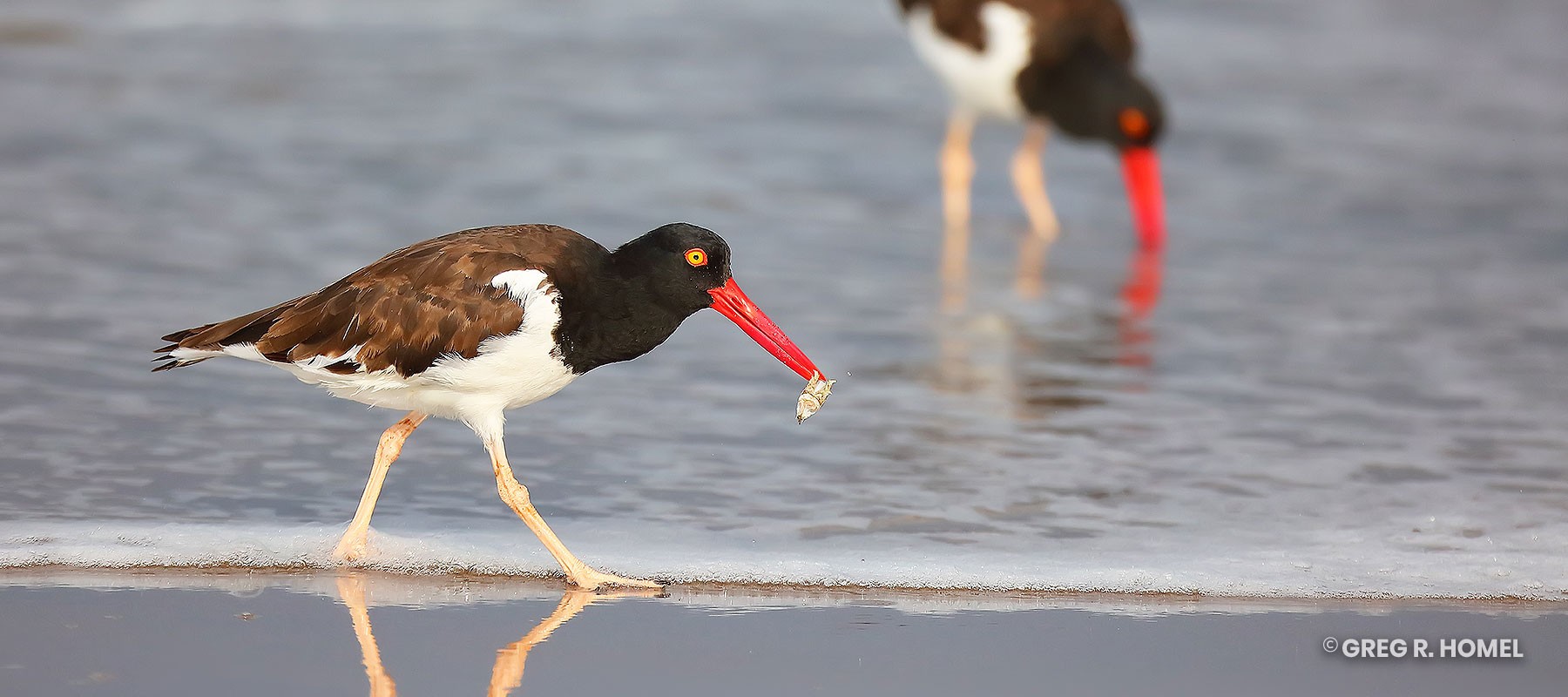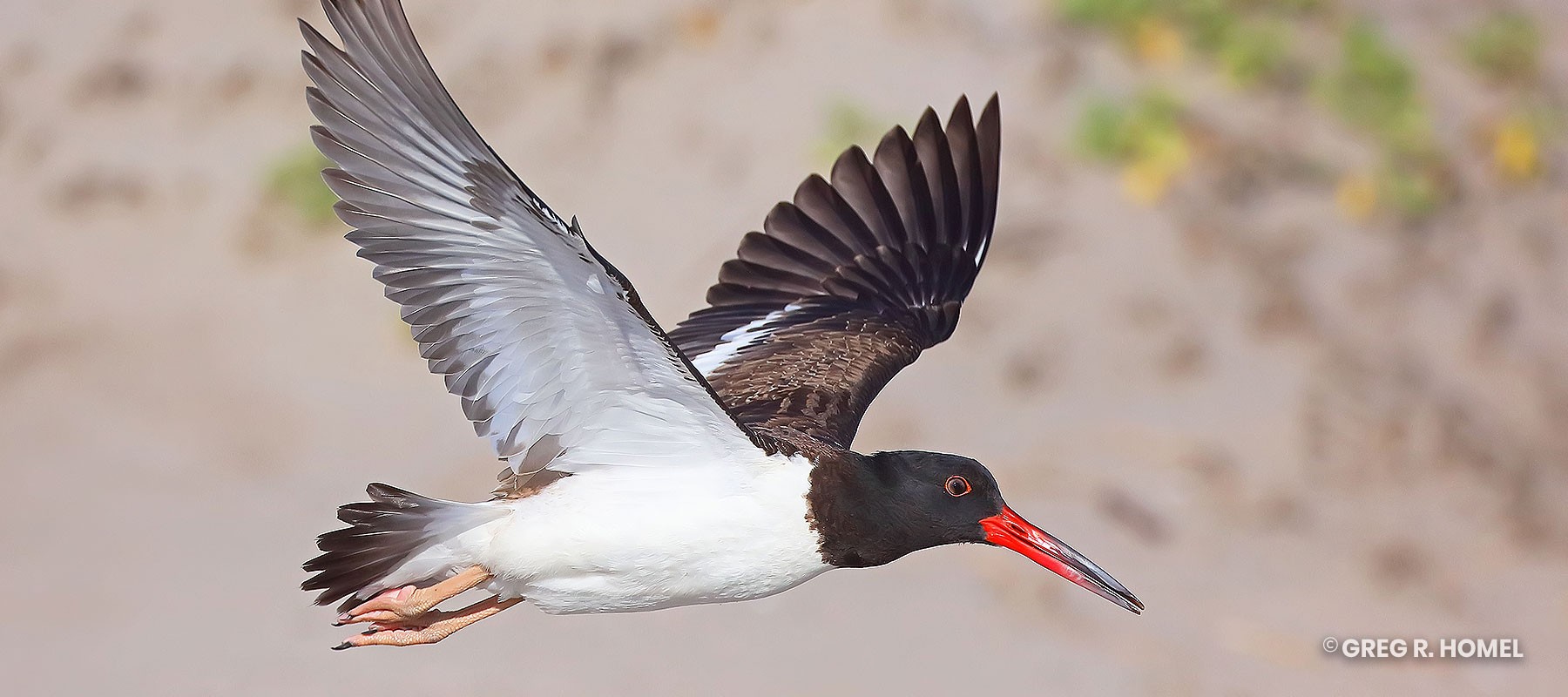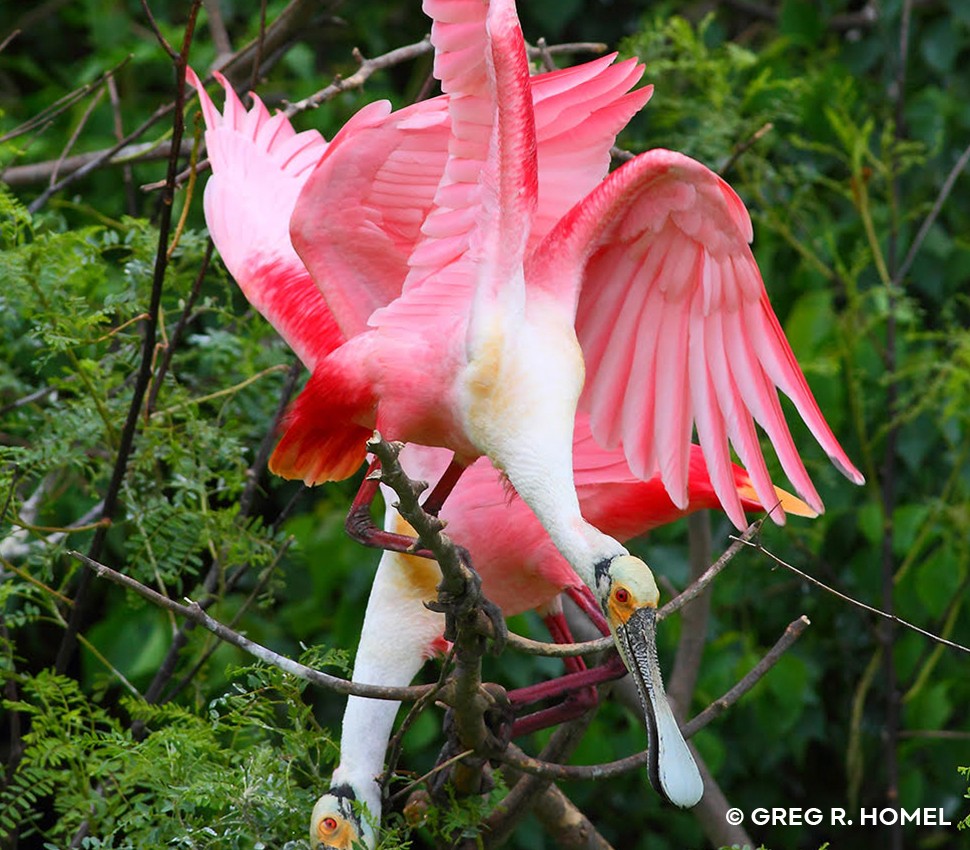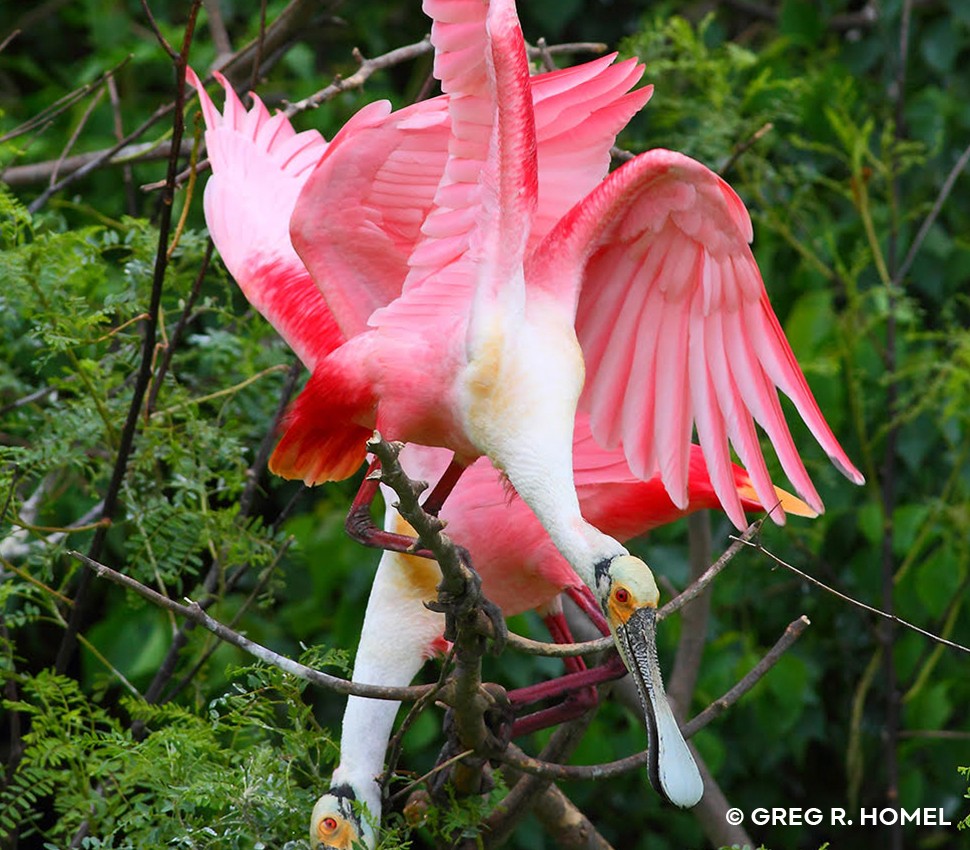San Blas, Riviera Nayarit
Birds to Watch: 400+
Location: San Blas » Nayarit
GPS: 21° 32' 35.99" N / -105° 17' 8.09" W ALT: 2611.5 ft
Incredible Birding from Mangroves to the Mountains on the Central Coast of Nayarit
San Blas has earned its reputation as perhaps the most famous birding destination on the Pacific coast of West-Central Mexico! In many ways it is still a quiet fishing village, but looks can be deceiving. The town has a surprising and romantic history dating all the way back to the 1700s Spanish Colonial Period, in fact. That legacy is still tangible today when you visit the impressive Contaduría Fort built on Cerro de Basilio overlooking the town and behold an almost incomprehensibly impressive, sweeping coastline, replete with guano-whitewashed islands in the distance beyond.
The town has a long and storied birding history, as well, especially where Christmas Bird Counts are concerned. For instance, a record 292 species were recorded here during the 1983 count, and tallies exceeding 200 species are still common in current times. One of your guides, Greg R. Homel, first visited San Blas on a 1987 countrywide pioneering birding road trip, then went on to become the Tucson Audubon Society’s count compiler one year during the early 1990s, and has regularly guided birders to San Blas most every year since!
The town’s rich natural and cultural heritage combined with lovely colloquial hotels, fresh seafood (and Banana Bread) that is on par with the world’s best, combined with a concession of readily available and skilled birding boatmen who can “easily” get birders up close and personal with a wide range of local specialties, day and night, have for decades attracted birders from the world over to this lovely coastal enclave of Nayarit.
Star birds include the country’s most readily findable Rufous-necked Wood-Rails, Ridgeway’s Rails and Northern Potoos, the only known viable Wood Stork colony in northwestern Mexico, readily findable Boat-billed Herons and Bare-throated Tiger-Herons in its mysterious mangroves, together with Mexican Woodnymphs, Military Macaws, Eared Poorwills, Mexican Barred (Cinereous) Owls and two impressive species of large forest eagles—the Black Hawk-Eagle & Black-and-white Hawk-Eagle in the nearby mountains, etc.
Complimenting San Blas’ rich onshore birding, its offshore birding is no less impressive, as easily arranged boating excursions can bring birders to guano-covered islands just offshore, where they can glass thriving seasonal colonies of Bridled Tern, Brown Noddy, Magnificent Frigatebird, Red-billed Tropicbird, and both Blue-footed and Brown boobies, very closely, in addition to breaching Humpbacked Whales, Pacific Bottle-nosed Dolphins, and Kemps Ridly Sea Turtles in the town’s blue tropical Pacific waters.
During the last 50 years or more birders have identified a tantalizing 400+ indigenous, endemic and migratory bird species in the San Blas region, including at least 36 Mexican endemics — roughly a third of the country’s total — within a 40 Km radius of the city’s center.
It’s no wonder Birders call San Blas paradise, and helps make clear why it has regular bird festivals each year!
Birding in Mexico happily offers 1-night, 2-night and 3-night plus special week-long birding options for birders wishing to seek out the spectacular birds of San Blas, Nayarit. Please let us know which option appeals most to you and we’ll make it happen!
*Please enquire if you are interested in learning more about our expanded, week-long birding option at San Blas, which also includes opportunities to see rare Spotted and endemic Aztec rails at Parque Ecologico, Tepic, and the endemic Aztec Thrush, Spotted Wren and Tufted Jay at a series of lovely cabins set high atop towering pine-clad cliffs in the majestic Sierra Madre Occidental—land of the Huichol culture.
– State of the Republic: Nayarit.
– Location: San Blas is a sleepy seaside town located on the tropical Pacific coast of Mexico, 160 km / 99 miles north or Puerto Vallarta and 64 km / 40 miles west of the State Capital, Tepic.
– Popularity of this tour: Very popular, as San Blas has long been one of Mexico’s most exciting and productive birding destinations, and for good reason, which see in our site descriptions!
– Short description: The area is very species rich. To date at least 400+ bird varieties have been recorded by resident and visiting birders in a 40 kilometer radius, at altitudes ranging from Sea Level at lovely Matanchén Bay to the summit of Cerro Alto and extinct Volcan San Juan, 2,210 m / 7,250’ above Rancho La Noria, in the nearly pristine Sierra San Juan Biosphere Reserve.
Founded in 1768, and once Mexico’s most important Pacific Port, today San Blas is a sleepy seaside town located on the tropical Pacific coast of Nayarit.
In a surprisingly manageable area logistically, and now easily accessible by road, 3 hours north of Puerto Vallarta, birders will find San Blas’ myriad habitats, comfortable lodging, readily available boating excursions—replete with local boatmen who know the best locations to seek out its aquatic and marine specialties—combined with some of the best seafood and banana bread in the country. In short: A cheerful and inviting birder’s paradise like no other! A literal feast for the eyes, the stomach and your life list!
Here, guano-covered Pacific islands, extensive and intact mangrove ecosystems—among the largest and best protected in Mexico—in addition to sweeping sandy beaches grading to Palm and deciduous Sinaloan thorn forest, montane tropical forest, and even high altitude encinal (pine-oak woodland) festooned in wild orchids, epiphytes and bromeliads, support a plethora of bird species that will whet any avid birder’s appetite for lifers.
See further historic details, here: https://en.wikipedia.org/wiki/San_Blas,_Nayarit
– A Complete Description of the Tour: See following detailed intinerary of our 1-day, 2-day and 3-day options we offer birders wanting to visit the San Blas region.
– Itinerary: See specific details by clicking the relevant itinerary tab
– Gallery: See Site Gallery by clicking this tour’s gallery tab
– Frequently Asked Questions or Recommendations to make your Visit as Enjoyable as Possible:
Click on this tour’s FAQ button for specifics
1 – Night Tour
QUICK OVERVIEW
DAY #1 QUICK OVERVIEW:
- – 06:00 – 11:30 am / Private Pickup in PV, Scenic drive to San Blas, Tropical Birding for Endemic, Indigenous & Migratory Birds at Camino al Cocodrilario / Crocodile Farm Road, Matanchén
*Out of consideration of others, please be punctual for your pick-up at 0600, sharp!
- – 12:00 – 16:00 p.m. / Check-in, Seafood Lunch & Siesta at the Garza Canela Hotel, San Blas
*If you are allergic to or do not prefer seafood, of course other options are available
- – 16:00 – 19:30 p.m. / Spotlighted Waterborne Boating Safari in search of Northern Potoos of the Rio La Tovera & one Overnight at San Blas
- – 20:00 – 21:00 p.m. / Dinner in San Blas then Overnight
*Because of today’s ambitious schedule, we will have our checklist party tomorrow during lunchtime in San Blas
DAY #2 QUICK OVERVIEW:
- – 06:30 – 12:15 a.m. / Rufous-necked Wood-Rails of Matanchén Bay & Waterborne Mangrove Birding—with large Crocodiles—on the Rio San Cristobal
- – 12:30 – 13:30 a.m. Seafood Lunch & Checklist Party in San Blas
- – 14:00 – 17:00 a.m. Scenic Return Drive to Puerto Vallarta before Sunset For more details of these tour option
2 – Night Tour
QUICK OVERVIEW
DAY #1 QUICK OVERVIEW:
- – 06:00 – 11:30 a.m. Private Pickup in PV, Scenic drive to San Blas, Tropical Birding for Endemic, Indigenous & Migratory Birds at Camino al Cocodrilario / Crocodile Farm Road, Matanchén
*Out of consideration of others, please be punctual for your pick-up at 0600, sharp!
- – 12:00 – 16:00 a.m. Check-in, Seafood Lunch & Siesta at Garza Canela Hotel, San Blas
*If you are allergic to or do not prefer seafood, of course other options are available
- – 16:00 – 19:30 p.m. Spotlighted Waterborne Boating Safari in search of Northern Potoos of the Rio La Tovera & one Overnight at San Blas
- – 20:00 – 21:00 p.m. Dinner in San Blas then Overnight
*Because of today’s ambitious schedule, we will have our checklist party tomorrow during lunchtime in San Blas
DAY #2 QUICK OVERVIEW:
- – 06:30 – 12:15 Rufous-necked Wood-Rails of Matanchén Bay & Waterborne Mangrove Birding — with large Crocodiles — on the Rio San Cristobal
- – 12:30 – 13:30 Seafood Lunch & Checklist Party in San Blas
- – 13:30 – 14:30 Short Siesta at Garza Canela
- – 14:30 – 17:30 Large Forest Eagles & Tropical Forest Birding Expedition to Terracería La Palma-Tecuitata, in the Mountains near San Blas
- – 18:30 – 19:30 Dinner & Second Overnight at Garza Canela,
San Blas DAY #3 QUICK OVERVIEW:
- – 06:30 – 10:00 Red-billed Tropicbirds, Boobies & Tropical Terns of San Blas’ Guano Islands
- – 10:30 – 11:00 General Birding at San Blas on our Return Route between the Harbor and the Hotel Garza Canela
- – 11:00 – 12:00 Take this time to Freshen Up and Pack in your Room before ahead of enjoying our Seafood Lunch and Checklist Party at San Blas
- – 12:00 – 13:30 Lunch and Checklist Party in San Blas
- – 14:00 – 17:00 Checkout of the Garza Canela, followed by a Scenic Return to San Blas before Sunset, with Possible Impromptu Birding Stops en route For more details of these tour option
3 – Night Tour
QUICK OVERVIEW
DAY #1 QUICK OVERVIEW:
- – 06:00-11:30 Private Pickup in PV, Scenic drive to San Blas, Tropical Birding for Endemic, Indigenous & Migratory Birds at Camino al Cocodrilario / Crocodile Farm Road, Matanchén
*Out of consideration of others, please be punctual for your pick-up at 0600, sharp!
- – 1200-1600: Check-in, Seafood Lunch & Siesta at Garza Canela Hotel, San Blas
*If you are allergic to or do not prefer seafood, of course other options are available
- – 16:00-19:30 Spotlighted Waterborne Boating Safari in search of Northern Potoos of the Rio La Tovera & one (1) Overnight at San Blas
- – 20:00-21:00 Dinner in San Blas then Overnight
*Because of today’s ambitious schedule, we will have our checklist party tomorrow during lunchtime in San Blas
DAY #2 QUICK OVERVIEW:
- 06:30-07:30 Rufous-necked Wood-Rails of Matanchén Bay
- 08:00-12:00 Waterborne Mangrove Birding—with large Crocodiles—on the Rio San Cristobal
- 12:30-13:30 Seafood Lunch & Checklist Party in San Blas
- 13:30-14:30 Short Siesta at Garza Canela
- 14:30-17:30 Large Forest Eagles & Tropical Forest Birding Expedition to Terracería La Palma-Tecuitata, in the Mountains near San Blas
- 18:30-19:30 Dinner & Second Overnight at Garza Canela, San Blas
Day #3 QUICK OVERVIEW:
- – 06:00-12:00 Birding the Lofty Highlands & “Hummingbird Flowering Forests” (seasonal) of the Sierra San Juan Biosphere Reserve
- – 12:30-13:45 Lunch in Tepic, with a Possible Stop at Parque Ecologico to search for the very attractive but elusive Spotted Rail and its more common endemic relative, the Aztec Rail
- – 14:00-16:30 Raptors & Military Macaws of Miridor del Aguila
- – 16:30-17:30 Return to San Blas for the night
- – 17:30-18:30 Dinner & Checklist Party at either the Restaurante Delfín or a nearby Restaurant in San Blas followed by our third overnight at the Garza Canela
DAY #4 QUICK OVERVIEW:
- – 06:30-10:00 Red-billed Tropicbirds, Boobies & Tropical Terns of San Blas’ Guano Islands
*Motion sickness countering tablets are recommended and will be provided as a courtesy if you want one
*Sea conditions dependent; if conditions are unfavorable we will bird for shorebirds at Shrimp Pond Road / Granja de Camarón and the “Singayta Jungle”
- – 10:30-11:00 General Birding at San Blas on our Return Route between the Harbor and the Hotel Garza Canela
- – 11:00-12:00 Take this time to Freshen Up and Pack in your Room before ahead of enjoying our Seafood Lunch and Checklist Party at San Blas
- – 12:00-13:30 Lunch and Checklist Party in San Blas
- – 14:00-17:00 Checkout of the Garza Canela, followed by a Scenic Return to San Blas before Sunset, with Possible Impromptu Birding Stops en route For more details of these tour option
Plus special week
long birding options
Private pickup at your Vallarta hotel or an appointed nearby location, followed by participant introductions and a description of your tour’s logistics, replete with a display map so you can get your bearings. For more details of these tour option
Bird Watch List
** The number of birds per trip may change
To better prepare for the adventure that awaits you, please study the following lists of popular birds, with specialties highlighted in bold print:
San Blas’ star birds, stratified according to habitat, include the following, in season:
A. On the nearby Offshore Islands: Heermann’s Gull, Brown Noddy, Bridled Tern, Elegant Tern, Brown Pelican, Red-billed Tropicbird, Magnificent Frigatebird, Blue-footed and Brown boobies, etc.
B. Extensive Mangrove Swamps: Northern Potoo; Ridgeway’s, Aztec and Rufous-necked Wood- rails; Bare-throated Tiger- and Boat-billed herons; Osprey and Common Black Hawk; Ringed and Green kingfishers; Mangrove Swallow; Northern Waterthrush and the chestnut-headed “Mangrove Warbler” form of Yellow Warbler, etc.
C. Fresh and Brackish Water Rivers and Lagoons: Black-bellied Whistling- and Muscovy ducks; Spotted Rail and Purple Gallinule; Limpkin; Black-necked Stilt, American Oystercatcher, Northern Jacana, and Stilt Sandpiper; Gull-billed Tern and Black Skimmer; Wood Stork; Anhinga; Least Bittern, Black-crowned and Yellow-crowned night-herons; Roseate Spoonbill, White and White-faced ibis; Snail Kite and Crane Hawk and Louisiana Waterthrush, etc.
D. Sinaloan Thorn Forest, Palm Forest and Tropical forest: Rufous-bellied Chachalaca and Crested Guan; Elegant Quail; Red-billed Pigeon; Groove-billed Ani, Lesser Ground-Cuckoo and Squirrel Cuckoo; Buff-collared Nightjar; Mexican Hermit, Plain-capped Starthroat, Golden-crowned Emerald, Mexican Woodnymph, Broad-billed, Cinnamon and Violet-crowned hummingbirds; Hook-billed Kite, Black-and-White and Black hawk-eagles, Great Black-Hawk, Harris’, White-tailed, Gray, and Short-tailed hawks; Ferruginous Pygmy-Owl and Mottled Owl; Citreoline & Elegant trogons; Russet-crowned Motmot; Golden-cheeked, Gila, Pale-billed and Lineated woodpeckers; Collared Forest-Falcon, Crested Caracara and Bat Falcon; Lilac-crowned and White-fronted parrots, Mexican Parrotlet and Orange-fronted Parakeet; Ivory-billed Woodcreeper; Masked Tityra, Gray-collared and Rose-throated Becards, Northern Beardless Tyrannulet, Greenish Elaenia, Pacific-slope, Vermilion, Dusky-capped, Nutting’s, Brown-crested, Social, Boat-billed, Sulphur-bellied flycatchers, Bright-rumped Attila, Great Kiskadee, Tropical and Thick-billed kingbirds; Golden, Black-capped, Bell’s, Warbling (the last three winter) and Yellow-green vireos; Sinaloa Crow, Black-throated Magpie-Jay, Green, San Blas and Purplish-backed jays; Black-capped Gnatcatcher; Happy and Sinaloa wrens; Blue Mockingbird; Orange-billed Nightingale-Thrush, Rufous-backed Robin; Scrub (Goldman’s) Euphonia; Rosy Thrush-Tanager; Rusty-crowned Ground-Sparrow, Stripe-headed and Olive sparrows; Yellow-winged Cacique, Black-vented, Hooded and Streak-backed orioles; Golden-browed and Golden-crowned, Lucy’s, MacGillivray’s, Black-throated Gray, Fan-tailed and Rufous-capped warblers; Red-crowned Ant-Tanager, Yellow Grosbeak, Red-breasted Chat, Blue , Varied and Painted buntings; Blue-black Grassquit; Ruddy-breasted and Cinnamon-rumped Seedeater, and Grayish Saltator, etc.
E. Encinal or High Altitude Pine -Oak-Juniper Woodland: Long-tailed Wood-Partridge and Singing Quail; Ruddy Quail-Dove; Eared Poorwill and Mexican Whip-Poor-Will; Chestnut-collared, White-naped and Greater Swallow-tailed swifts; Blue-throated Mountain-gem, Rivoli’s, Bumblebee, Broad-tailed, Calliope, Berylline, and White-eared hummingbirds; Zone-tailed and Red-tailed hawks; Flammulated Owl, Whiskered Screech-Owl, Northern (Mountain) and Colima pygmy-owls, Barred (Cinareous), Stygian and Northern Saw-whet owls; Northern Flicker, Acorn, Hairy, Arizona and Gray-crowned woodpeckers; Military Macaw; White-striped Woodcreeper; Greater Pewee, Tufted, Pine, Cordilleran and Buff-breasted flycatchers; Bridled Titmouse; Bushtit (black-eared form); Spotted Wren; Eastern Bluebird, Brown-backed Solitaire, Russet Nightingale-Thrush and Aztec Thrush; Gray Silky-flycatcher; Olive Warbler; Elegant Euphonia; Black-headed Siskin; Green-striped and Rufous-capped brushfinches, Yellow-eyed Junco, and Rusty Sparrow; Audubon’s (Dickey’s) Oriole; Crescent-chested, Tropical Parula, Grace’s, Townsend’s, Hermit and Red-faced warblers, Painted and Slate-throated redstarts; Hepatic, Flame-colored and Red-headed tanagers, etc.
See full eBird list of each site we will be visiting by clicking each specific bird list link, below.
All or most of following eBird Hotspots may be visited on this incredibly exciting Birding in Mexico overnight excursion, depending on whether you choose our one, two or three night San Blas options. Please inquire for pricing then give us your preference, and we’ll gladly make it happen for you.
*A week-long option is also available for the ultimate San Blas experience.
*Space is limited, so please inquire for availability.
- a. Estanque de Aguas Residuales de San Blas (263 species): https://ebird.org/printableList?regionCode=L583588&yr=all&m=
- b. Camino al Cocodrilario (247 species): https://ebird.org/printableList?regionCode=L3576420&yr=all&m=
- c. Cocodrilario de San Blas (244 species): https://ebird.org/printableList?regionCode=L512360&yr=all&m=
- d. Camino Real–La Bajada a Jalcocotán (243 species): https://ebird.org/printableList?regionCode=L5539383&yr=all&m=
- e. Granja de Camarón San Blas (284 species): https://ebird.org/printableList?regionCode=L620587&yr=all&m=
- f. Isla del Rey (251 species): https://ebird.org/printableList?regionCode=L454901&yr=all&m=
- g. Laguna de Zoquipan (163 species): https://ebird.org/printableList?regionCode=L1039953&yr=all&m=
- h. Mirador del Aguila (pueblo) (161 species): https://ebird.org/printableList?regionCode=L507807&yr=all&m=
- i. Playa del Borrego (193 species): https://ebird.org/printableList?regionCode=L1854981&yr=all&m=
- j Playa Las Islitas (127 species): https://ebird.org/printableList?regionCode=L1248607&yr=all&m=
- k. Playa Matanchén (172 species): https://ebird.org/printableList?regionCode=L1262821&yr=all&m=
- l. Reserva Ecológica Sierra de San Juan–Cerro de San Juan (271 species): https://ebird.org/printableList?regionCode=L689255&yr=all&m=
- m. Reserva Ecológica Sierra de San Juan–La Noria (369 species): https://ebird.org/printableList?regionCode=L502887&yr=all&m=
- n. Rio La Tovara (297 species): https://ebird.org/printableList?regionCode=L293450&yr=all&m=
- o. Rio San Cristobal (247 species): https://ebird.org/printableList?regionCode=L503034&yr=all&m=
- p. Roca Elefante (63 species): https://ebird.org/printableList?regionCode=L5085099&yr=all&m=
- q. Ruta Piedra Blanca/Bahia Matachen (61 species): https://ebird.org/printableList?regionCode=L3182614&yr=all&m=
- r. Tecuitata pueblo (271 species): https://ebird.org/printableList?regionCode=L689255&yr=all&m=
- s. Terracería La Palma-Tecuitata (184): https://ebird.org/printableList?regionCode=L2798902&yr=all&m=
Bring your Camera Gear and Binoculars
It is assumed you have your own binoculars, as this is requisite to fully enjoy all BIM outings!
If you are also an avid bird and / or wildlife photographer, BIM offers select Bird Photography Expeditions with world renowned photographer, writer, lecturer and bird tour leader Greg R. Homel, throughout Mexico… and the world, for that matter.
Please inquire if you are interested in learning more about our bird and wildlife photography-oriented expeditions, or take a look at our website.
Our day trips—unless otherwise specified as bird photography-centric—are focused on birding specifically, and photography as an exciting sidebar.
It goes without saying that you will be glad to have a camera on this expedition, just for the scenic value alone. So bring your camera if you have one!
Regardless of the venue, all tour participants should consider themselves encouraged to bring their cameras and practice this enjoyable pastime during any excursion.
Recommended equipment should include digital cameras with telephoto lenses equal to the equivalent of at least 400 mm or greater (in 35 mm terms) for your bird photography efforts to be worthwhile in the first place. Bird photography tours aside, tripods are not recommended, since it’s reasonable to assume they may interfere with other participants’ freedom of mobility and our general logistics.
Most modern lenses and many of today’s cameras are equipped with motion countering technology, anyway, making a tripod unnecessary under the conditions we will be operating within.
Please don’t forget to bring extra batteries, chargers and memory cards specific to your camera brand, as well.
Lens tissue should also be considered requisite to keep your lenses clean or to wipe incidental water droplets off of their (and your binoculars’) objective elements, as environmental conditions are unpredictable in the often wild regions we will be visiting. If you do not have “lens cleaning tissues,” don’t fret—in a pinch normal, one ply, unscented, napkins or toilet paper will work just as well as expensive lens tissue.
Cloth and clothes will not work to clean your camera or binocular lenses, as they often absorb skin oils and grease and can smudge these on your optics, with predictable results.
Use paper to clean all lenses for best results and clear images.
*Please inquire about loaner binoculars if you or one of your party does not have binoculars but would like to partake in this excursion. We may have one or two available, free of charge, to lend you. Apologies in advance if the loan binoculars are already claimed or unavailable for this tour.
Recommended footwear for today’s excursion?
All-terrain shoes with ankle support are recommended for our trips into the Sierra San Juan Biosphere Reserve; tennis shoes are also acceptable—especially in the San Blas lowlands—if you do not have high-top all terrain footwear, but we highly recommend the former due to possibly rough, rutted, rocky or slippery surfaces, all of which are dependent on recent weather conditions, especially in the mountains.
What kind and Color of Clothes should I Wear?
Lightweight clothing—especially light weight slacks—displaying neutral or earth tone colors (no bright colors or whites please, as they may alert often shy birds—such as the skulky Rufous-necked Wood-Rail—to our presence from afar, preventing our close approach) are recommended. Short sleeve shirts are fine, but if you have lightweight, long-sleeve tops, so much the better.
We also recommended you don a hat or cap with a visor or brim (again, no bright colors or whites), to avoid glare, water reflections and sunburn in the tropical, often quite hot climate we will be operating within at San Blas.
Except at our hotel or when swimming at the beaches, we discourage your wearing of shorts, skirts, bathing attire, or cutoff shirts that expose the mid-rift while on expedition.
*Please click on the button covering Insect Repellent for a detailed explanation about biting insects at San Blas. Thank you for your understanding.
Weather on this excursion—especially during the summer Monsoon season—is highly variable according to altitude. We will visit a diverse array of habitats and elevations on this excursion, ranging form Sea Level to as high as 2000 m / 6561’ at Rancho La Noria and surrounding peaks.
However, tropical weather is unpredictable at best, so be prepared for this contingency, knowing that at any time of year San Blas’ weather can turn surprisingly wicked, so please carry a light duty windbreaker and a fleece to provide comfort during a sudden downpour while on our boating excursions, and to provide warmth during the sometimes chilly early morning hours in the surrounding mountains, respectively.
There can also be a marked difference between daylight and nighttime temperatures, so be sure to carry a windbreaker and a fleece on any of our nocturnal Northern Potoo / American Crocodile excursions to La Tovera Springs. It’s better to have a windbreaker and not need it, than to need it and not have it, if you catch our drift!
Sun Protection?
YES. San Blas is famous for its clear skies and sunny conditions. This is the “tropical sun” however, so those unaccustomed, beware! We will be exposed to direct sunlight while on our boating excursions, in particular.
For these reasons we recommended using sun screen with a minimum Sun Protection Factor of 30 (preferably 50 SPF or higher) on your face and other exposed skin to avoiding sunburns, especially in the coastal and marine environments we will be visiting by foot, vehicle or watercraft, or all of the above.
Insect Repellent?
YES. San Blas is as famous for it’s Jejenes or “no-see-ums,” as it is for its great birding, but mosquitos are not too much of a problem during the dry season (November-May).
Insect repellents containing DEET will vastly improve your outdoor comfort on this expedition.
Biting insects can seem almost absent on most of our regional expeditions, and for most of the daylight hours, but can appear unexpectedly, so be prepared by arming yourself with both knowledge and technology.
At San Blas, when its infamous biting insects do make their appearances, you’ll know it right away. They have a cultural significance here, and are likely part of the reason San Blas was never despoiled by mass tourism and towering resort hotels. And besides, as mentioned, they are easily repelled using modern insect repellents containing DEET. In a way, we can be thankful for their presence, and the birds who depend on them as food certainly are!
They are most likely to be active during the humid, still, early morning and especially during late crepuscular hours, when it’s cloudy or overcast. This is a time when birders are likely to be outdoors, as well… so come prepared!
Surprisingly, they can even get you while standing in the shade at mid-day here, or while enjoying seafood and refreshments in the shade of any of the covered, palapa-style beachside restaurants that abound at Bahia Matanchén, for instance.
They do not seem to like direct sunshine, and retreat into the shadows for the same reasons you do. So again, be ready for this contingency.
This is why Birding in Mexico discourages you from wearing short pants or skirts during our San Blas outings.
Interestingly, and perhaps counterintuitively, biting insects are not much of a nuisance on our boating trips through the mangroves of the Rios San Cristobal or La Tovara, at San Blas, even at night. Perhaps they are not adapted to expect their “meals” (i.e., YOU!) to arrive via watercraft on the otherwise barren liquid surfaces of area rivers….
To be sure to avoid being bitten by black flies (i.e., “Jejenes” or “No-See-Ums”) or Mosquitoes, we recommended that you carry repellent with DEET as its active ingredient wherever you go on expedition, applying it liberally on an impromptu basis to counter these blood suckers, while spraying your pant cuffs and socks for chiggers before every outing, regardless of the season.
You’ll be glad you did, especially during the wet season (June-October)!
Where chiggers are concerned (as chiggers like and are spread by livestock and livestock may be present at any of the interior destinations we will be visiting from the lowlands to the mountains), you may not even realize you’ve been bitten until 12-24 hours after exposure if you do not preempt by spraying your socks, shoes and pant cuffs; and by then it’s too late and the itching can be formidable.
Thankfully, it’s easy to avoid chigger bites by applying repellents containing DEET, and spraying them liberally, as mentioned, onto your pant cuffs, socks and shoes before every outing, regardless of the season.
We recommend a repellent that is sprayable via a non-aerosol propellent, since the pump style repellents may leak inside your daypack, potentially ruining your food, camera gear, or other often expensive equipment carried. Roll-on-style repellents do not efficiently cover your skin’s surface, nor your pant cuffs or socks, so you are discouraged from using them in favor of a propelled spray.
Bring your Camera Gear
If you are an avid bird and / or wildlife photographer, Birding in Mexico offers select Bird Photography Expeditions with world renowned photographer, writer, lecturer and bird tour leader Greg R. Homel throughout Mexico… and the world, for that matter.
Please inquire if you are interested in learning more about our bird and wildlife photography-oriented expeditions.
Our day trips—unless otherwise specified as bird photography-centric—are focused on birding specifically, and photography as an exciting sidebar.
Regardless of the venue, all tour participants should consider themselves welcome, or even encouraged, to bring their cameras to practice this enjoyable pastime during any excursion.
Where San Blas is concerned—this is an overnight excursion during which there will be many opportunities to photograph birds and wildlife, including possibly large American Crocodiles.
Recommended equipment should include digital cameras with telephoto lenses equal to the equivalent of at least 400 mm or greater for your bird photography efforts to be worthwhile in the first place. Tripods are not recommended on excursion, since it’s reasonable to assume they may interfere with other participants’ freedom of mobility—especially on boats—and our logistics.
Most modern lenses and many cameras are equipped with motion countering technology, anyway, making a tripod unnecessary under the conditions we will be operating within.
Please don’t forget to bring extra batteries and memory cards specific to your camera brand, as well.
Lens tissue should also be considered requisite to keep your lenses clean or to wipe incidental water or sea spray off of their (and your binoculars’) objective elements, as environmental conditions are unpredictable in the often wild regions we will be visiting, by land, river and sea. If you do not have “lens cleaning tissues,” don’t fret—in a pinch normal, one ply napkins or toilet paper will work just as well as expensive lens tissue sold by photography outfits.
What is this Expedition’s Level of Physical Difficulty?
Visitors to San Blas will generally encounter easily negotiable roadside birding and foot paths (some with ruts, rocky stretches or muddy conditions, depending on recent weather) in the lowlands, grading to more moderately challenging walks in the highlands… where you may also notice the effects of altitude, as at Cerro’s Alto, San Juan, and at Rancho La Noria, in the Sierra San Juan Biosphere Reserve.
You may also be required to board floating watercraft (we have able bodied staff to assist you), and may have to wade in shallow water between the shoreline and your boat on occasion and during unexpected “expedition stops,” though this scenario is unusual.
Nonetheless, you should be prepared for this contingency with good cheer and a spirit of adventure.
We will provide free of charge, motion sickness options for our offshore excursions, though this is not necessary on any of our mangrove-ecosystem boating excursions along the Rios San Cristobal or to La Tovera, nor is it necessary at Laguna de Zoquipan.
Walking conditions here range from EASY to MODERATE throughout the excursion.
There is 2000 m / 6561’ potential altitudinal gain on this excursion—depending on whether you choose from our 1-3 night options—and you should be prepared for this, though our vehicle will be doing most of the “climbing” for you as we access altitudinally stratified birding habitats within the mountains, especially the highlands of the Sierra San Juan Biosphere Reserve.
San Blas and surrounding birding areas are not wheelchair accessible.
If possible, we tend to adjust our walking pace to match the physical capabilities of each group.
In the event that two leaders will accompany your group (which is not guaranteed), it is possible that we will split the group to accommodated clients of varying athletic capabilities.
If you have specific concerns, please don’t hesitate to contact us in advance of your trip and we will do our best to provide you with accurate information pertinent to your specific needs, while advising you whether or not you would gain commensurately from the excursion you are contemplating.
What is Included on my Tour?
- All Birding in Mexico excursions include one or more specialized, Government-certified (applicable to Alejandro Martinez, a Mexican Citizen, or other Mexican guides), bilingual guide(s)
- Your guide(s) will carry their own private binoculars at all times during the tour, and where productive, a high quality spotting scope, as well
- Complimentary Birding in Mexico checklists specific to the region will be handed out at your pickup point and an excellent regional field guide authored by Greg R. Homel will be offered for sale
- Breakfast-snacks are included
- Throughout this tour, all meals, lodging, ground and water-borne transportation, entrance fees, complimentary snacks, fruit, purified water, and soft drinks are provided with pleasure
- Private ground transportation with pickup and drop-off between Puerto Vallarta and San Blas is also included
- For your safety and wellbeing a First aid kit is carried on all Birding in Mexico excursions
- If you are not a Mexican Citizen, please carry a valid copy of or your actual Passport (or Passport Card) on all Birding in Mexico excursions, since occasional government or military “Puestos” (road checks) may be encountered and require this.
- Mexican Citizens should have valid government-issued identification with them, as well
- Also it is wise to bring sufficient cash and your ATM card (please know your PIN), to cover unexpected expenses in the event of an emergency

